
Tequila is a distilled beverage made from the blue agave plant, primarily in the area surrounding the city of Tequila 65 km (40 mi) northwest of Guadalajara, and in the Jaliscan Highlands of the central western Mexican state of Jalisco.

Sisal is a species of flowering plant native to southern Mexico, but widely cultivated and naturalized in many other countries. It yields a stiff fibre used in making rope and various other products. The sisal fibre is traditionally used for rope and twine, and has many other uses, including paper, cloth, footwear, hats, bags, carpets, geotextiles, and dartboards. It is also used as fibre reinforcements for composite fibreglass, rubber, and concrete products. It can also be fermented and distilled to make mezcal.

Mezcal, sometimes spelled mescal, is a distilled alcoholic beverage made from any type of agave. The word mezcal comes from Nahuatl mexcalli, which means "oven-cooked agave", from metl and ixcalli. Traditionally the word "mezcal" has been used generally in Mexico for all agave spirits and it continues to be used for many agave spirits whether these spirits have been legally certified as "mezcal" or not.

Agave americana, commonly known as the century plant, maguey, or American aloe, is a flowering plant species belonging to the family Asparagaceae. It is native to Mexico and the United States, specifically Texas. This plant is widely cultivated worldwide for its ornamental value and has become naturalized in various regions, including Southern California, the West Indies, South America, the Mediterranean Basin, Africa, the Canary Islands, India, China, Thailand, and Australia.

Agave attenuata is a species of flowering plant in the family Asparagaceae, commonly known as the foxtail or lion's tail. The name swan's neck agave refers to its development of a curved inflorescence, unusual among agaves. Native to the plateaux of central west Mexico, as one of the unarmed agaves, it is popular as an ornamental plant in gardens in many other places with subtropical and warm climates.

Agave mitis is a plant species native to the Mexican states of Hidalgo, Tamaulipas and San Luis Potosí, referred to as Agave celsii in many publications.

Raicilla is a distilled spirit originating in the south western part of the Mexican state of Jalisco. Like tequila and mezcal, it is a product of the agave plant.

Agave salmiana is a species of the family Asparagaceae, native to central and southern Mexico. It is also reportedly naturalized in South Africa, Italy and Spain, specially in the Canary Islands.

Agave is a genus of monocots native to the hot and arid regions of the Americas and the Caribbean, although some Agave species are also native to tropical areas of North America, such as Mexico. The genus is primarily known for its succulent and xerophytic species that typically form large rosettes of strong, fleshy leaves. Agave now includes species formerly placed in a number of other genera, such as Manfreda, ×Mangave, Polianthes and Prochnyanthes.

Agave cupreata is a species of plant in the family Asparagaceae, and is found only on mountain slopes of the Rio Balsas basin in the Mexican states of Michoacán and Guerrero at elevations of 1,200-1,800 meters. A. cupreata is a long-lived plant with mature leaves reaching between 40–80 cm in length and a flowering stalk of 4–7 m. The age of maturity for A. cupreata is variable, but generally occurs at any time from 5–15 years. A monocarpic perennial which does not reproduce clonally, A. cupreata allocates its accumulated resources toward the production of a single inflorescence and dies following the production of seeds.

Agave parviflora is a species of succulent perennial flowering plant in the asparagus family, known by the common names Santa Cruz striped agave, smallflower century plant, and small-flower agave. It is native to Arizona in the United States and Sonora in Mexico.

Agave guiengola, common name "Creme Brulee Agave", is an evergreen plant belonging to the family Asparagaceae. This species is endemic to the State of Oaxaca, Mexico. It grows on limestone slopes, at an elevation of about 100–1,000 metres (330–3,280 ft) above sea level. It is associated with cacti and succulents. The species name guiengola refers to the Cerro Guiengola, the mountain where the species was first discovered.
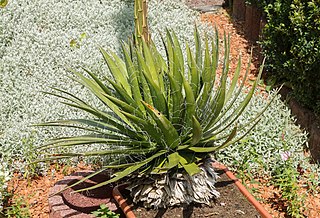
Agave filifera, the thread agave, is a species of flowering plant in the family Asparagaceae, native to Central Mexico from Querétaro to Mexico State. It is a small or medium-sized succulent plant that forms stemless rosette up to 3 feet (91 cm) across and up to 2 feet (61 cm) tall. The leaves are dark green to a bronzish-green in color and have very ornamental white bud imprints. The flower stalk is up to 11.5 feet (3.5 m) tall and is densely loaded with yellowish-green to dark purple flowers up to 2 inches (5.1 cm) long. Flowers appear in autumn and winter.
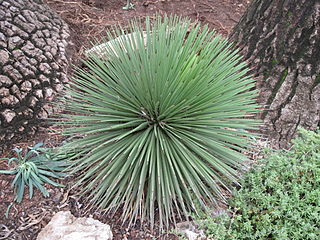
Agave stricta, the hedgehog agave, is a species of flowering plant in the family Asparagaceae, native to Puebla and Oaxaca in Southern Mexico. Growing to 50 cm (20 in) tall, it is an evergreen succulent with rosettes of narrow spiny leaves producing erect racemes, 2 m (7 ft) long, of reddish purple flowers in summer. The foliage may develop a red tinge in the summer. The plant is also known to produce pincushion-like offsets as it grows.
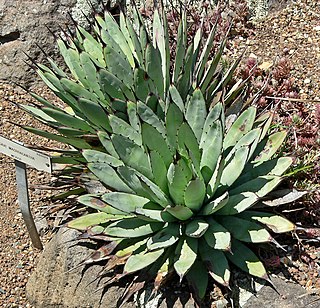
Agave macroacantha, the black-spined agave or large-thorned agave, is a species of succulent flowering plant in the family Asparagaceae naturally occurring in Oaxaca and also near the town of Tehuacan in the State of Puebla, Mexico.
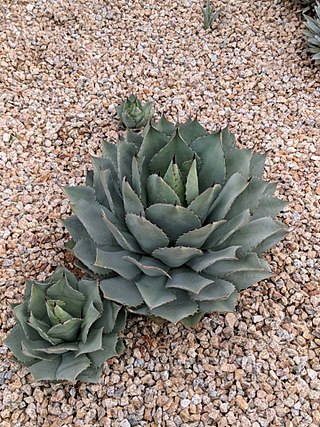
Agave potatorum, the Verschaffelt agave, is a species of flowering plant in the family Asparagaceae. A smallish and attractive succulent perennial, it is native to partial desert areas of Mexico from Puebla south to Oaxaca.
Agave univittata, the thorn-crested century plant or thorn-crested agave, is a plant species native to coastal areas of southern Texas and northeastern Mexico, at elevations less than 100 m. It has been widely named Agave lophantha by botanists including Howard Scott Gentry, but the name A. univittata is older and therefore more in accord with nomenclatural rules of botany.

Agave atrovirens, called maguey verde grande is a type of century plant native to Oaxaca, Pueblo and Veracruz states in Mexico. It is the largest of all the Agaves, occasionally reaching a weight of two long tons. Each succulent leaf can be up to 14 feet 9 inches in length and weigh one hundred pounds (45 kg) apiece. In the variety A. a. cochlearis these leaves can also be up to 16 inches (41 cm) wide. As in other Agaves the leaves form a rosette, from the center of which, after many years, a panicle of flowers emerges on a long scape or peduncle which at first looks like a vast stalk of asparagus, but later grows to more than forty feet in height, develops side branches near the top and numerous flowers which open red and gradually turn yellow. Agave salmiana, the species with the tallest inflorescences, is frequently lumped with A. atrovirens as the varieties A. a. salmiana or A. a. sigmatophylla. If this is valid, then A. atrovirens also has the tallest inflorescences of any Agave, and of any known plant. Each rosette flowers and fruits once, then dies. According to Fayaz this is one of the species which makes offsets or "pups". A. atrovirens is one of the pulque agaves used in the production of mezcal.

Agave gigantensis is a large, flowering agave plant found in Baja California Sur, Mexico. Its name is derived from the area of origin, not its large size. The plant is distinguishable by its red and purple leaves during flowering season. It is able to survive in harsh, rocky conditions and prefers dry and warm environments. The flowers of A. gigantensis are arranged in small clusters which diverge from a main branch. Unlike many other agave plants, A. gigantensis has been traditionally used in food and medicine by communities of western Mexico.
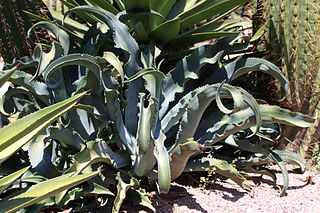
Agave gypsophila is a species of plant in the Asparagaceae family and is endemic to the Mexican state of Guerrero. The specific epithet, gypsophila, means gypsum loving.
























